“Bereshit” lunar mission - searches for the first lunar library after the accident of its carrier have begun

100 grams of a bit of digital and analog content of humanity protected by Kapton tape versus 150 kg of the Bereshit device and 76 kg of fuel on its board in a collision with the Moon, and this, taking into account the estimated fall rates: 100 MJ (megajoules) of kinetic energy and 1000 MJ of chemical energy.
The organization of the Arch Mission Foundation is trying to understand whether the library sent to the moon has been preserved, and where it can be there.
In fact, this search for the lunar library provides interesting calculations of the fall characteristics of the Bereshit apparatus and the energy that could have been released during this accident.
The main characteristics of the mission and the lunar vehicle "Bereshit":
- the beginning of the mission: February 22, 2019;
- end of the mission: an accident occurred (falling to the moon) when trying to land on April 11, 2019, a complete loss of communication with the device at an altitude of 149 meters;
- the trajectory of movement to the Moon (in fact, the maximum possible): complex, changeable by performing a series of maneuvers (turning on the engines for several seconds or even minutes) to increase the apogee of its elliptical habitat after each orbit around the Earth, then transfer to the lunar orbit, followed by landing ;
- the height of the Bereshit apparatus is about 1.5 meters, a diameter of 2 meters (2.3 meters between landing supports);
- weight 530 kilograms with fuel (fuel weight - 380 kg), 150 kg without fuel;
- scientific instruments: magnetometer (sent part of the scientific data while the device was in orbit of the moon and in the process of landing), an array of laser corner reflectors (they will be searched for by the LRO probe);
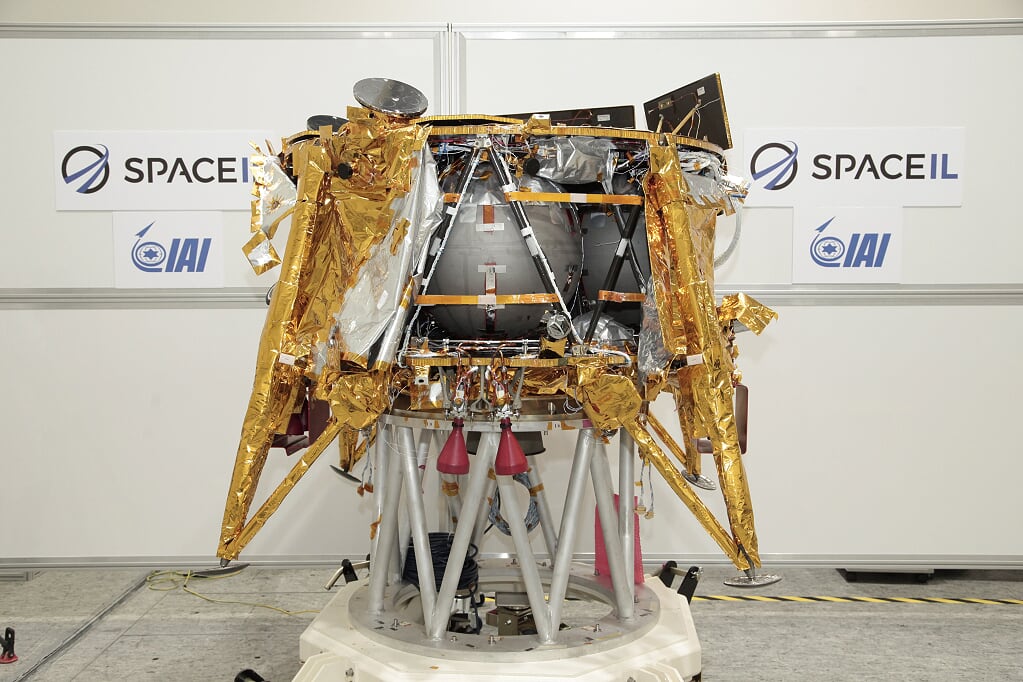
- the Bereshit apparatus was supposed to make a soft landing on April 11, 2019 on a dark lava plain known as the Sea of Clarity, not far from the region where astronauts of the Apollo 17 mission landed on December 11, 1972.
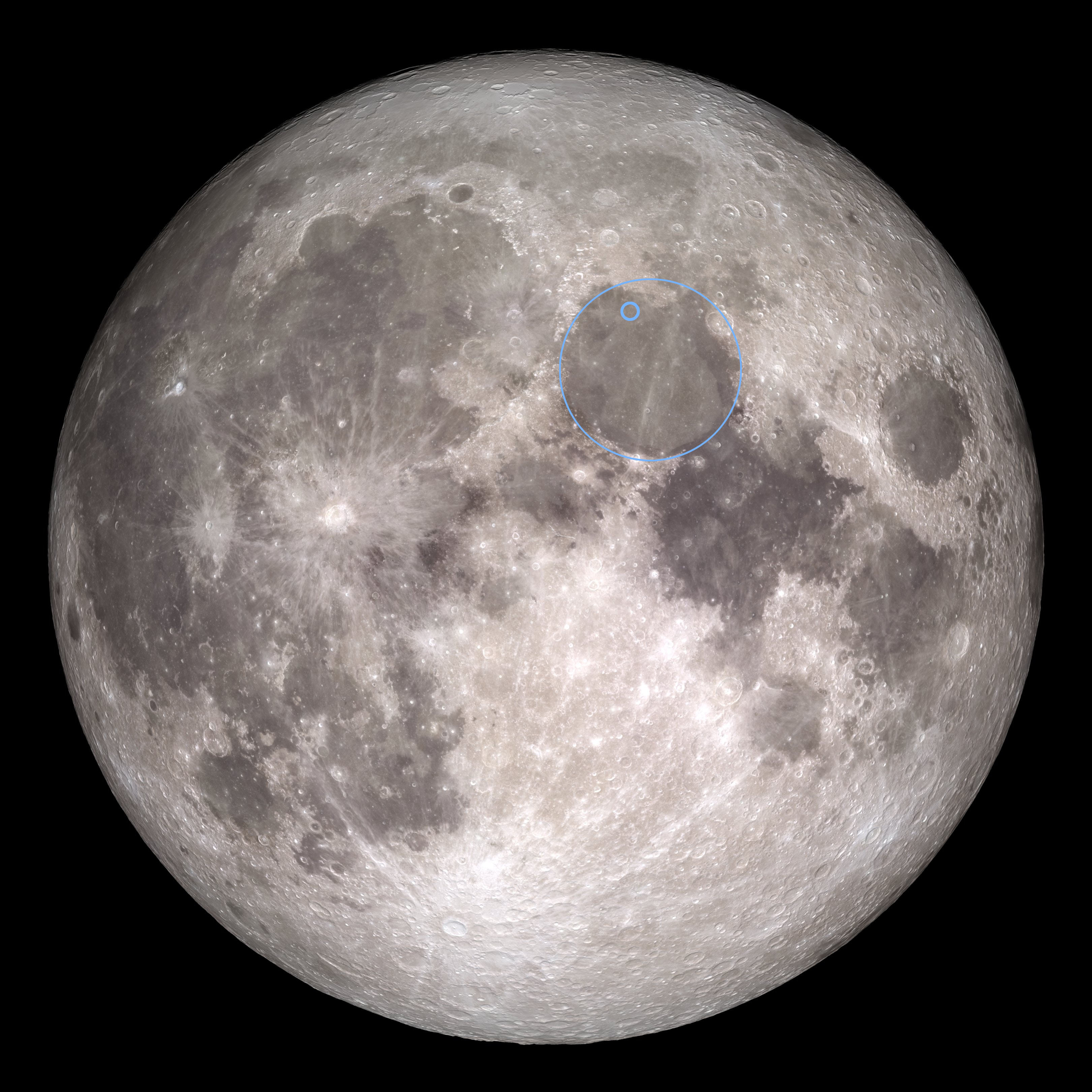
Unfortunately, due to a software error in the operation of the on-board computer and the engines of the Bereshit apparatus, an emergency occurred during the landing, which led to the shutdown of the main engine and uncontrolled fall at high speed onto the lunar surface, according to calculations from 20 to 50 km from the calculated the landing site the device flew over.
About the electronic library, which flew to the moon on the device "Bereshit."
In addition to two scientific instruments (a magnetometer and an array of laser corner reflectors), there was an additional non-research payload on board the Bereshit apparatus - the first lunar library, the Archive of Human Knowledge.
The development and implementation of this part of the lunar project was carried out by the Arch Mission Foundation , which in the global sense works to preserve information about human civilization, including creating backup libraries of human knowledge.
Using NanoArchival technology , the Arch Mission Foundation documents the most important information about humanity.
Physically, the lunar library “Archive of human knowledge” on the Bereshit device is a 100 gram small envelope container (145x145 mm) with 25 thin plates (40 microns the thickness of one plate).


On the first (upper) 4 plates, information is recorded in analog format in the form of an array of microscopic photographs, graphs, pictures, texts in various languages, including:
- basic information about the Earth and earthlings,
- linguistic data on earthly languages,
- texts of government documents Israel,
- the national cultural works of Israel,
- information about the participants of the Bereshit project,
- information on decoding the underlying digital recordings.
Images on these 4 plates can be easily seen at a magnification of a hundred times under a simple microscope.
The second part of the library is digital (about 200 GB of information in unpacked form, 100 GB in the archive) and consists of the 21st plate on which DVD is recorded with more densely packed data on the inhabitants of the Earth and their achievements, including:
- all the English version of Wikipedia,
- several tens of thousands of novels and reference books,
- information about 5 thousand languages,
- world art works,
- technical and scientific reference books and other numerous materials.
The plates of the lunar library are stacked and placed in a special envelope (consisting of multilayer insulating material), in addition, the plates are protected by a kapton tape.
This “Archive of human knowledge” was made with the expectation that it would be stored on the moon inside the Bereshit apparatus in open space for tens of thousands of years without degradation.
But, the unexpected happened - the Bereshit apparatus crashed during landing and the archive, unfortunately, also suffered (or was destroyed, which is more likely).

What else was in the lunar library can be found in this pdf .
First archive


plate:

Plate sizes: The plates are placed on top of each other and are not yet compressed:

Plates are prepared and packaged in an envelope:

What can be seen on analog plates:






Video of placing a container with a library inside the Bereshit apparatus (in fact, engineers later additionally fixed an envelope with a library inside the apparatus):
Of course, the envelope container with the plates had to be placed in a protected box and on the Bereshit apparatus somehow designated the location of the lunar library (and placed on the top of the apparatus, and not under the tanks), so that it was clear on the Moon that here lies where exactly in the apparatus, but these moments were omitted in this project, apparently.

At the moment, the Arch Mission Foundation is looking for a lunar library after the accident of the Bereshit apparatus:

“The landing was a little more bumpy than expected, but the black boxes of the aircraft are experiencing much stronger collisions, and our drives are less fragile than they are. Small light objects - like our 100g library - do better with collisions. Probably [due to the impact] they were thrown back several kilometers - like a frisbee with 30 million pages flying over the moon. "
The organization of the Arch Mission Foundation is not going to give up and they launched a new project - to determine the location of the "lunar library".
An open document was created in Google Docs with detailed information about the archive library and its contents, as well as with the details of the crash of the Bereshit device shared by SpaceIL.
Thus, the Arch Mission Foundation is trying to solve the problem:
“If a spaceship carrying objects weighing 100 grams crashes into the surface of the moon at a speed of 2000 miles per hour (3300 kilometers per hour), then how far away these objects will fly away from the crash site ? "
Data obtained from the analysis of telemetry during the landing-fall of the Bereshit apparatus:

According to preliminary estimates, the Bereshit apparatus flew 16-20 km further than the calculated landing site. And the place of its fall must be sought in a zone with a diameter of 140 km in the area of the lunar surface planned for landing earlier in the Sea of Clarity.
Red numbers - the height of the Bereshit device above the lunar surface at two fixed points from which photos of the lunar surface were sent.
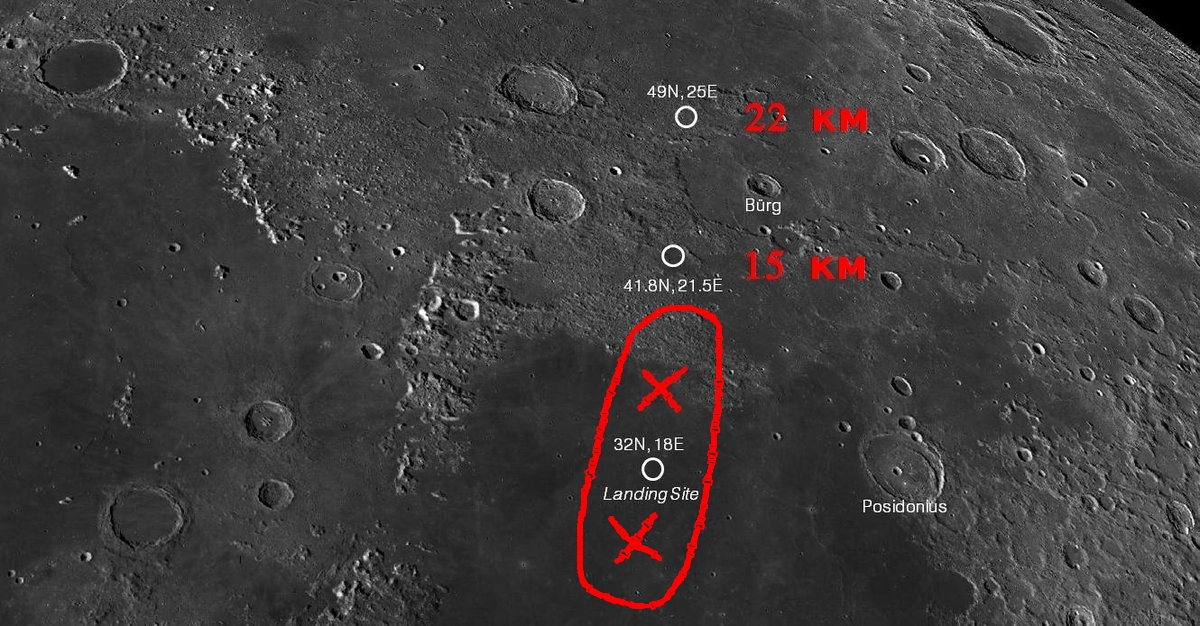
Calculation of the energy released during the fall of the Bereshit device.
The latest data from the SpaceIL MCC:

The total mass of the Bereshit device when it hits the lunar surface: 150 kg (the device itself) +76 kg (remaining fuel) = 226 kg.
It turns out that the kinetic energy of the Bereshit apparatus at the moment of collision is 103 MJ, which is equivalent to the explosion of 25 kg of TNT (trinitrotoluene), since 1 kilogram of TNT = 4.184 MJ.
The calculation of kinetic energy was carried out using this resource.

But what about the chemical energy that could have been released from a fuel explosion?
The fuel of the Bereshit apparatus is hydrazine (monomethylhydrazine), the oxidizing agent is a mixture of nitrogen oxides (MON), there were 380 kg in the tanks at the start, and 76 kg remained before falling to the surface.
According to calculations anddata from here , from 973 MJ to 1,483 MJ of chemical energy could be released during the explosion of fuel tanks, although this situation is unlikely and there most likely was not such a powerful explosion, since there was still an oxidizing agent in a 1 to 1 ratio and there was a faster thermal reaction upon impact on the surface of the moon.
About a quick thermal reaction - with a speed of more than 900 m / s the apparatus fell to the surface, and the tanks there are 50-70 cm in diameter, out of 380 kg of fuel there are 76 kg in them - 20% of fullness. There was very little time for the collision process and a lot of destruction of elements immediately with the release of energy and the formation of a crater.
Moreover, there were 4 tanks (76/4 = 19 kg in one tank):


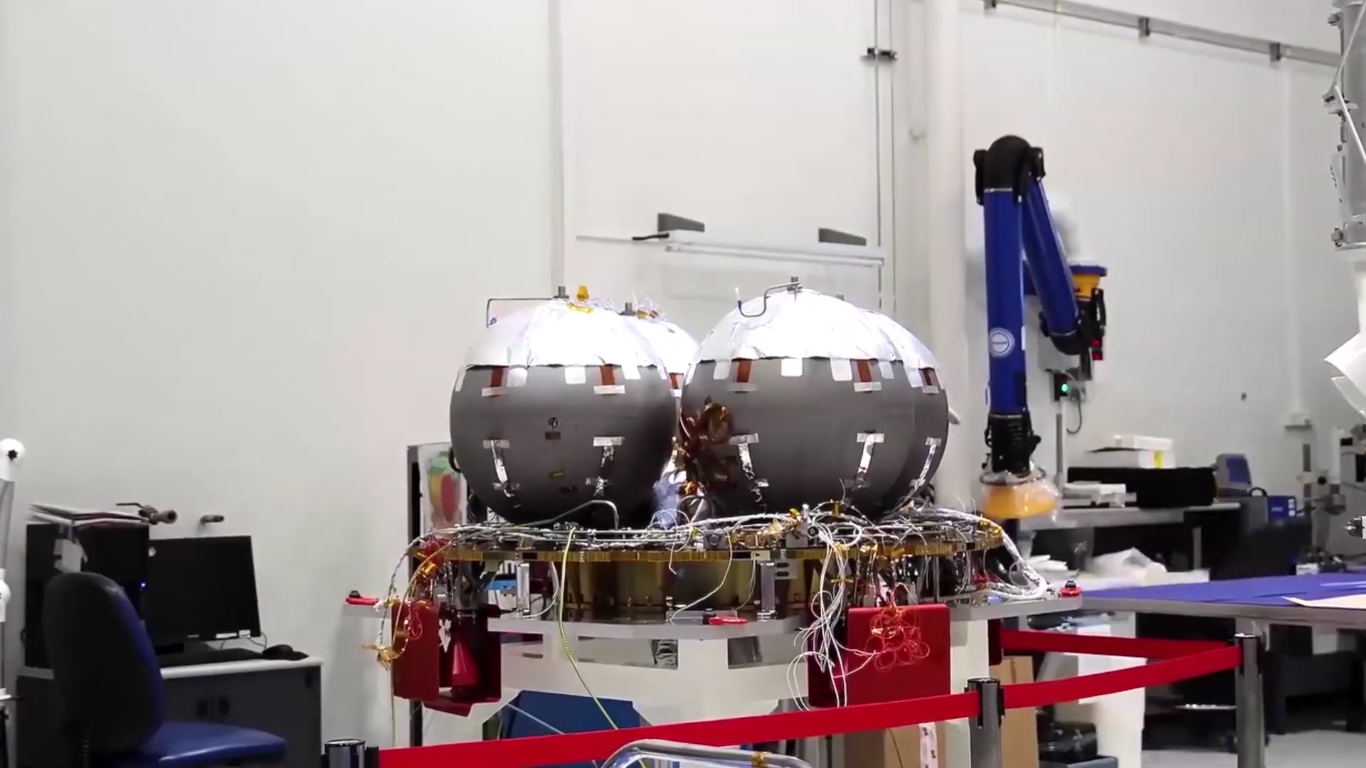
And they are protected from above and below by such bases:


How the Bereshit apparatus was assembled:
All the same, the absence of a lunar atmosphere strongly affects such shots:

Calculation of the diameter of the crater formed from the fall of the Bereshit apparatus.
Crater Handbook, page 6, figure 6 .

D (crater diameter in meters) = 0.55679 * (M ^ (1/3)), where M = TNT (in kg).
It turns out that the estimated diameter of the crater: 0.55679 * (25 ^ (1/3))) = 1.62 meters.

It is clear that this calculation does not take into account the fact that the Bereshit apparatus fell to the surface of the Moon at an angle, as well as the difference in the characteristics of the earth and lunar soil.
However, now we are clear about the approximate order of accident data (energy and possible diameter of the crater) from the calculations and there is a small chance that during the fall of the Bereshit apparatus, part of the lunar library remained intact and will be found in the future by space researchers on the moon.
About the search for the Bereshit device at NASA.
The Bereshit device crash site in SpaceIL and NASA are almost exactly known from telemetry and analysis of the last seconds of the crash.
The last 4 seconds of the device’s life according to the data in the MCC (from 678 to 149 meters decrease):
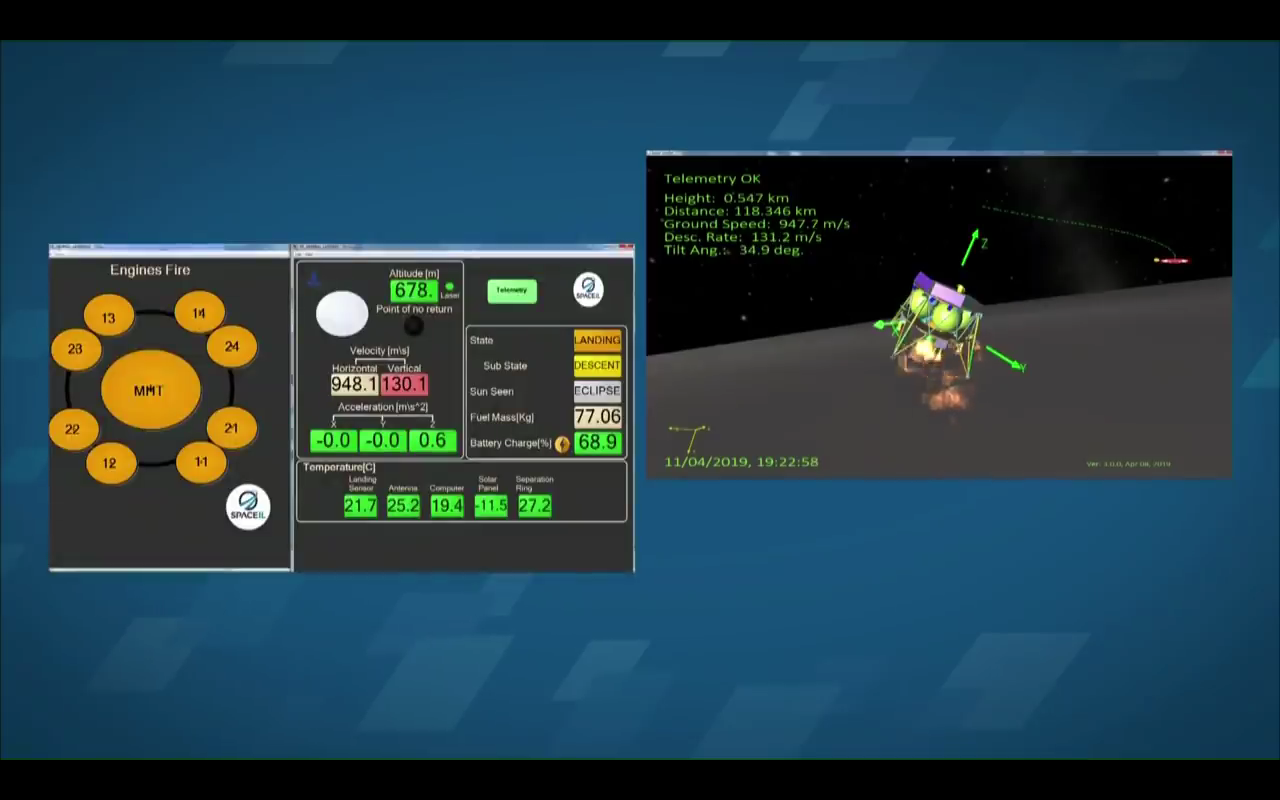
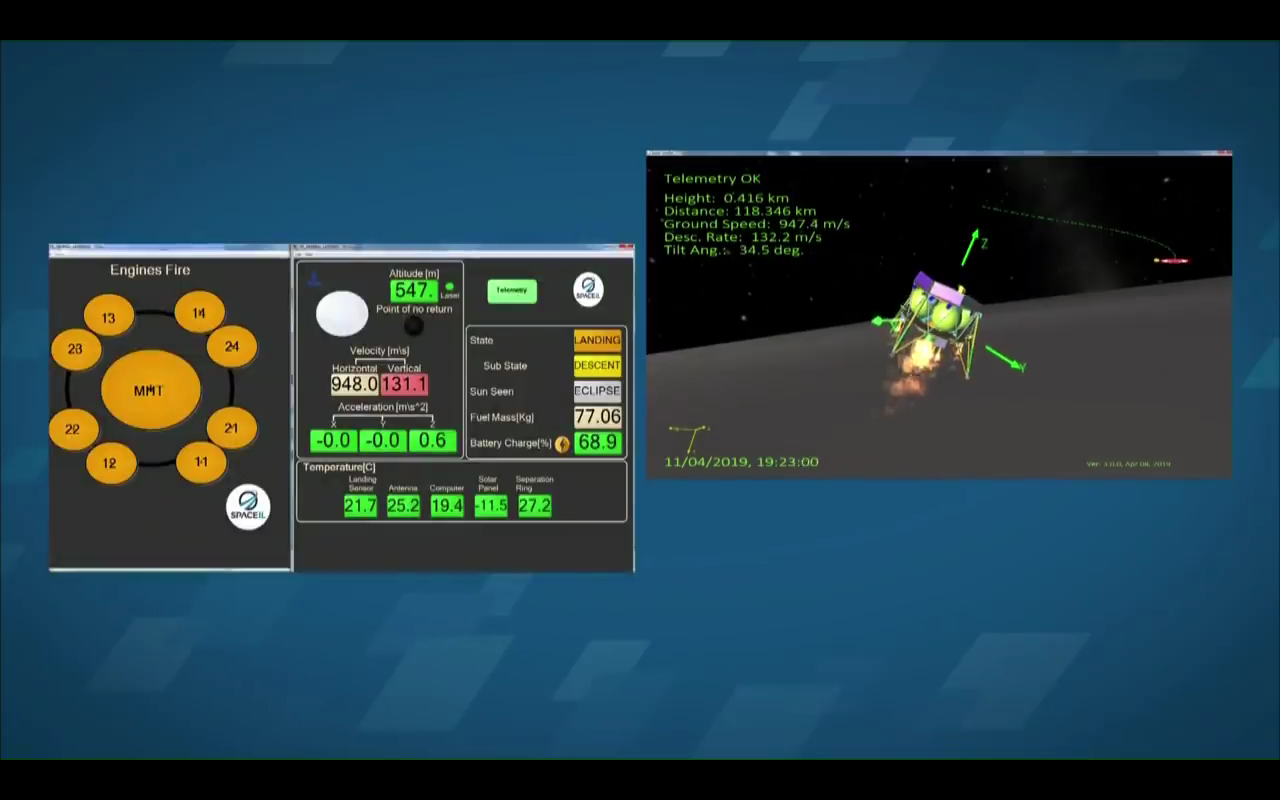


At 19:23 UTC on April 11, 201, the telemetry data from the Bereshit device completely ceased to come to the SpaceIL MCC.
NASA plans to use the LRO probe to examine the area of impact of the Bereshit apparatus, in the hope that the elements of the array of laser corner reflectors have not collapsed and will be located on the surface of the moon.
Reflectors were fixed on the upper part of the device and when it fell could bounce, scatter, roll over and burrow in the lunar soil.
But even if only part of the reflector element is available for reflection of the light pulse, this fact will be recorded by the equipment on the LRO probe.
The LRO laser altimeter (NASA lunar orbital probe), designed to compile altitude maps, will send laser light pulses to the corner reflector at the site of the Bereshit’s incidence, and then measure how long it takes the light to go back.
Using this technique, NASA and SpaceIL engineers plan to be able to locate the remains of the Bereshit device.

It seems to me that corner reflectors could still “survive” in such an accident, since they were placed on top of the Bereshit device, but the library plates were folded (were flattened in the wreckage) in the device’s structure when it fell, and now they are in the crater, which was formed from the fall of the Bereshit apparatus on the moon under lunar soil.
It is assumed that the diameter of the formed crater after falling from 3 to 5 meters (5-10 meters when calculated with a kinetic energy of 108 MJ). The Bereshit apparatus crashed into the lunar surface at a small angle (~ 8 °), the crater can be elongated.
On April 22-23, 2019, the LRO probe (Lunar Reconnaissance Orbiter) will fly over the fall region of the Bereshit device, so we are waiting for new photos from this NASA probe, which may help to find the place of the fall of the Bereshit device on the Moon.

Why is it so important to know the estimated size of the crater and the preliminary accident area of the Bereshit apparatus?
The height of the Bereshit apparatus was about 1.5 meters and a diameter of 2 meters (2.3 meters between the landing supports). This is slightly larger than the Chinese Yutu-2 rover, and this LRO rover was able to capture visually, albeit in several passes, taking photos of the surface at the landing site on the far side of the moon.
In case of successful landing of the Bereshit apparatus, the LRO probe would be able to photograph the landing site and we could see this fact.
Similar fixation of objects on the lunar surface by the LRO probe.
Launched by NASA on June 18, 2009, the lunar orbiting probe (LRO) continues to be used to obtain a large amount of valuable scientific information and on February 1, 2019 managed to pass almost above the landing site of the Chinese Chang'e-4 station - Statio Tianhe on the far side of the moon.
The photo was taken by the LRO probe from a height of 82 kilometers, a resolution of 0.85 meters (33 inches) per 1 pixel, which allowed us to get a clearer picture of the location of the Chang'e-4 module and, finally, to see the contours of the Yutu-2 rover in several pixels ".

To understand the dimensions in the photo, the data on the Chang'e-4 modules are as follows:
- the Chang'e-4 pull-down module (4.4 meters between the opposite landing supports, weight 1200 kg.);
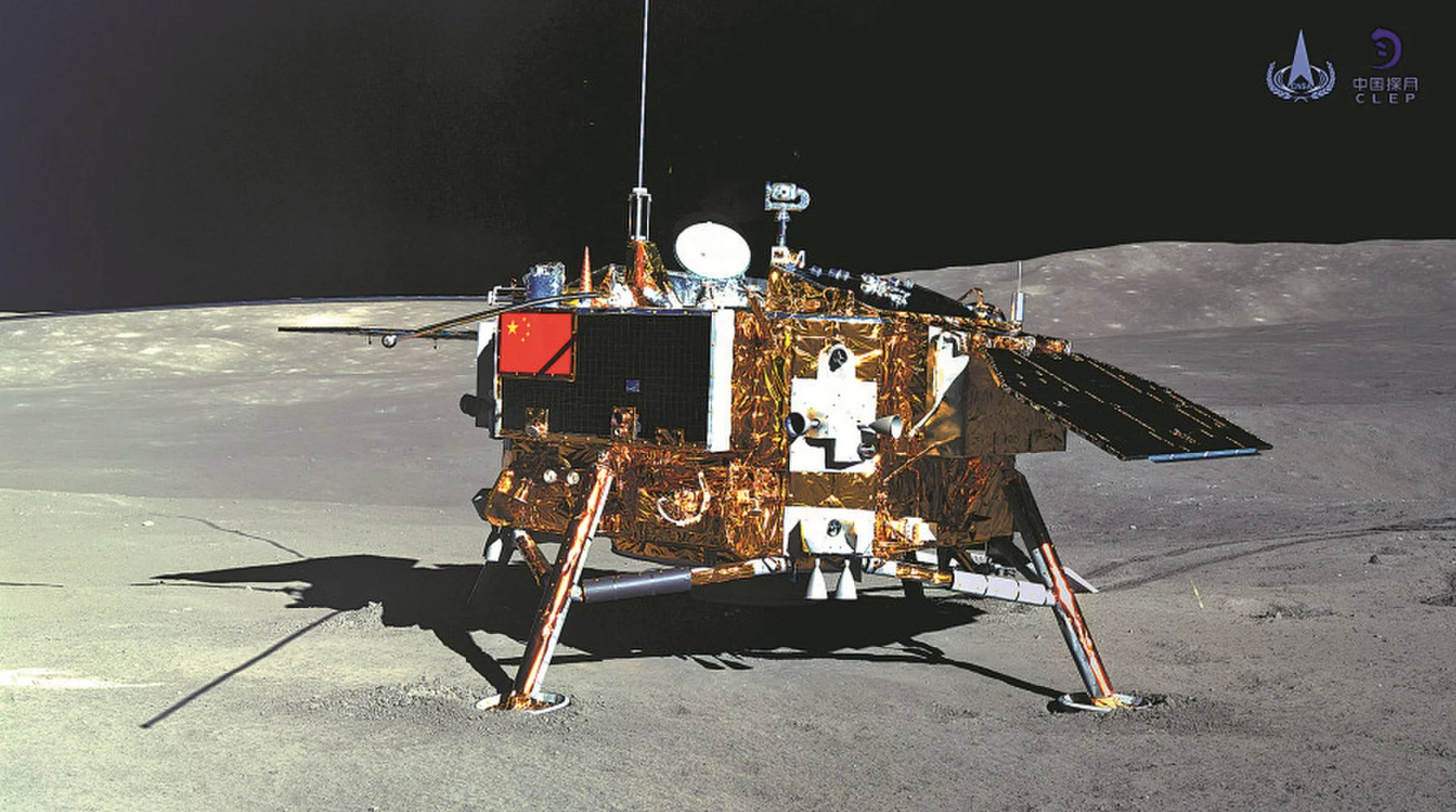
- Yutu-2 rover (height 1 meter, width 1 meter (without solar panels), 1.5 meters in length, two folding solar panels, six wheels, weight 140 kg.).

During a new survey with the LRO probe, the Yutu-2 rover was located 29 meters northwest of the Chang'e-4 landing craft.
Comparative photographs taken by the LRO (NASA Lunar Orbital Probe) of the Chang'e-4 mission landing site on the back of the Moon at different times (the descent module and the rover, which moves further and further from the landing site, are visible in the photo):
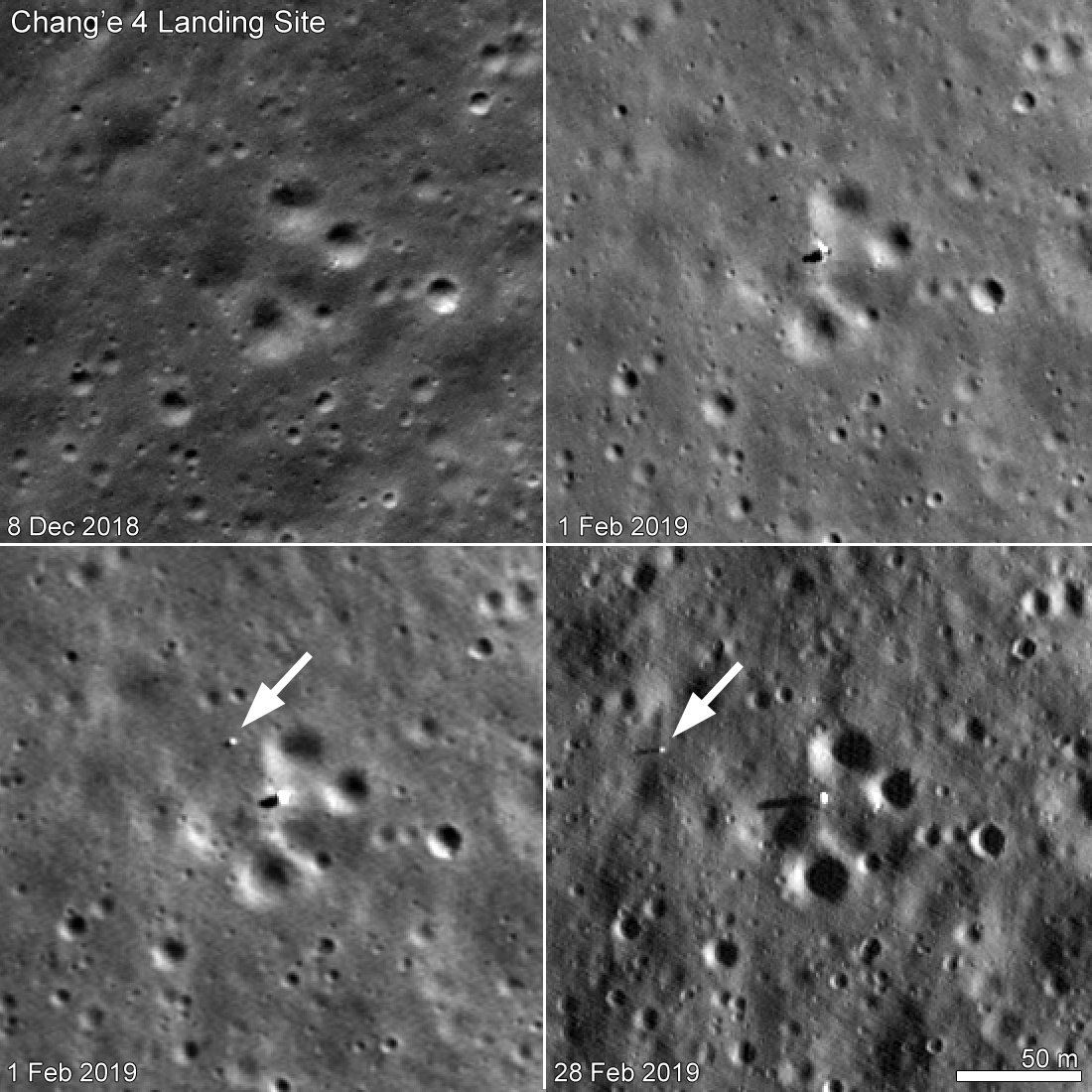
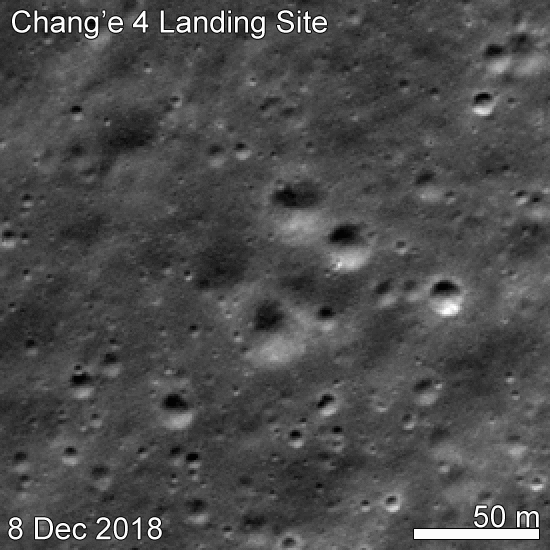
Thus, in the case of with the fall of the device "Bereshit" on the lunar surface - the LRO probe should fixthe appearance of a new crater in the zone of the alleged accident, and this will be done by comparing the surface photographs before and after the accident, as well as these photographs must be taken at different times so that the angle of incidence of sunlight on the moon's surface is different.

If the actual size of the crater after the fall of the Bereshit apparatus is from 3 to 10 meters, this fact should be confirmed in new photographs from the LRO probe, which we expect soon.
There are a lot of small craters in the zone of the alleged fall.

